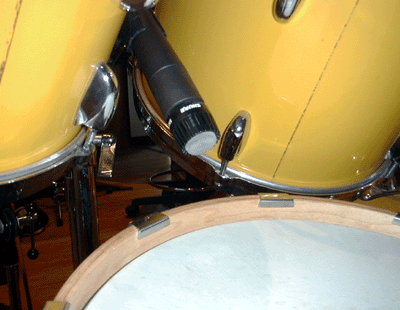Snare Drum
I experiment often when recording snare drums. If you want to EQ the snare drum mic, use a very clean equalizer that can handle very high peak levels without distorting. Since a lot of the snare drum is heard in the overhead mics, I take the time to make sure the drummer is using the right snare drum for the song. Thinking that you will just re-trigger a snare sample replacement later, because the snare drum and the sound you're getting sucks, is the wrong attitude! Tuning is super important to me and almost like a guitar, the snare drum must be tightened after each take. You must start with a good (new?) head and make sure, like all drums, the lugs are all equally tensioned. Fig. 5 shows the typical snare drum mic position. I was lucky with this drummer; he had a space between the two toms enabling me to sneak in a brand new Shure SM57. The only other place to get a mic in is from the hi-hat side...not ideal because the drummer will probably hit it.
 | | Fig. 5 Typical Snare Drum Microphone Placement |
In general, I always aim snare and tom mics directly at the center of the drum head where the drummer should hit the drum. I will record as much of the transient part of the drum hit as I can. If I find I have too much "hit" and not enough tonality, then I'll move the mic slightly downward, in front of where it is hit. Try to make sure not to aim the mic at a lug by positioning it equidistantly between two lugs. Pulling the mic back away from the snare drum greatly changes the sound. Doing this, generally produces a bigger and rounder tone with less attack and a little more ambience. I will still aim the mic at the center of the drum and if the back of the mic touches the rack tom, use a right angle XLR connector.
 | | Fig. 6 Underneath Snare Microphone Placement |
Fig.6 shows typical under-snare miking. I always mic the underside of the snare drum even though I end up using it only about 30% of the time. Depending on the snare drum when a drummer hits hard, the attack or "stick" sound is so loud that you have to reduce the snare drum recording level so the peaks don't distort. You end up with very little of the snares' sound. You can use just about any mic under the snare and sometimes I'll tape the mic right to the post of the snare drum stand with gaffer's tape if I can't get a stand positioned in and around all the other stands. Very little of this microphone is used in my close snare drum mix...no more than 20%. I always flip phase on this mic since the top mic is facing it. Using the bottom mic can brighten the snare sound differently than an equalizer. I sometimes roll all the low end out of the bottom mic so it does not add any tone from the bottom head.
Microphone Choices
Some of my favorite dynamics for snare drum miking include: a new Shure SM57 or Beta57, Sennheiser MD-421U (if you can fit it in), and an ElectroVoice RE-20 (if you have room). Good condensers are: Neumann KM184 or KM185, KM84, Sony C-37A, AKG C-414TLII and C-451 and C-452, and an old Norelco C-60. The C-452 has a whole accessory set of swivels and attenuator pads that make getting in close on the snare drum easy. The new Audix ADX-90 condenser clips to the rim of the drum and is perfect when floor space for mic stands is limited.
Other Goodies For Getting Great Drum Sounds
Sennheiser Evolution Series Of Drum Mics
Shure's KSM44 Condenser Mic
Audix i5 Dynamic Mic
Audix Micro-D Series Drum Mic
HQ SoundOff Bass Drum Mute
Shure's KSM32 Condenser Mic
AKG C451B Reissue Condenser Mic
Monster Cable's Turbine Pro In-Ear Speakers
UKKO Contact Drum Mics By B-Band
Heil Microphones' PR 48 Kick Drum Mic
Heil's PR 20 UT Dynamic Mic
Audio-Technica' KP-Drum Mic KitPak
Granelli G5790 Right-Angle SM57 Mic
Kelly Shu Kick Drum Mic Isolation/Mount
|